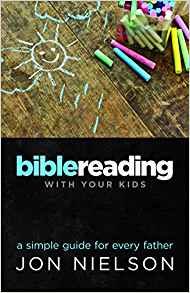As we come to chapter three of discussing Bible Reading With Your Kids, we are building on the foundations of the first two chapters. If you haven’t read them or our articles about them, read chapter 1 here and chapter 2 here.  These chapters laid out the biblical reasons to pursue reading the Bible with our kids and some practical aspects of how this helps us parent and disciple. The next question Nielson asks is what most of us would ask next, “How should I approach this?” Before going any further, try to think of 2 or 3 ways you would approach reading the Bible with your kids. I’ll list several of mine at the end. Unless we think through some ideas and trust God with the outcome, the idea of reading the Bible effectively with our kids can feel like standing at the bottom of a cliff face with no plan to climb up and we can be overwhelmed. You don’t need to be overwhelmed!
These chapters laid out the biblical reasons to pursue reading the Bible with our kids and some practical aspects of how this helps us parent and disciple. The next question Nielson asks is what most of us would ask next, “How should I approach this?” Before going any further, try to think of 2 or 3 ways you would approach reading the Bible with your kids. I’ll list several of mine at the end. Unless we think through some ideas and trust God with the outcome, the idea of reading the Bible effectively with our kids can feel like standing at the bottom of a cliff face with no plan to climb up and we can be overwhelmed. You don’t need to be overwhelmed!
 Nielson’s first vital encouragement is to jump in with your kids and do it no matter where you think you are at with your own knowledge of the Bible. Even if you are reading the Bible for the first time, you can read sections with your kids. This is something Christian dads of all stages spiritually can do. If you run into questions you can’t answer, get a couple of good resources (we can help with that) or come talk to a pastor or elder. We would love to help dads understand the Bible so that they can pass it on. He says, “Don’t put it off until you feel ready; just get started.” Such good advice! Do you want to know the hidden secret that can overcome this feeling of inadequacy that Satan uses to stop us? Every dad I’ve talked to about family worship, including myself, feels ill-equipped or inadequate at times! The weight of training little souls is staggering. Praise God the power is in God’s Word, not our eloquence. Don’t let this trap stop you from jumping in and trying it.
Nielson’s first vital encouragement is to jump in with your kids and do it no matter where you think you are at with your own knowledge of the Bible. Even if you are reading the Bible for the first time, you can read sections with your kids. This is something Christian dads of all stages spiritually can do. If you run into questions you can’t answer, get a couple of good resources (we can help with that) or come talk to a pastor or elder. We would love to help dads understand the Bible so that they can pass it on. He says, “Don’t put it off until you feel ready; just get started.” Such good advice! Do you want to know the hidden secret that can overcome this feeling of inadequacy that Satan uses to stop us? Every dad I’ve talked to about family worship, including myself, feels ill-equipped or inadequate at times! The weight of training little souls is staggering. Praise God the power is in God’s Word, not our eloquence. Don’t let this trap stop you from jumping in and trying it.
He then gives several ideas to help us be more prepared to help our kids understand God’s Word as we read it. The first is to consider that their young ears may not comprehend as easily, so think about how you would talk to someone learning English (they are!) Speak a little slower and try to use simpler words when talking about the verses you just read. Don’t use the long 50 cent Christianize words when they are young. Use words they understand. Men, our wives are often masters of this. Enlist their help.
His next hint may be tougher to notice, but look for places where the Bible uses abstract concepts like metaphors or complex concepts and give them concrete examples. This can be tough for us to see because as adults, we deal with the abstract all the time, but kids are concrete thinkers until around 12 or 13 years old. They need us to simplify. For instance, let’s say I tell my kids that Jesus took the penalty for my sins and paid the price I couldn’t pay so I could have salvation. This is extremely important and true, but it may be difficult for a child to understand. We still need to teach this, but perhaps add a concrete example like this . . . If your brother broke mommy’s vase and is going to have to do a bunch of extra chores as a consequence to pay for it, would he be happy? You’re right, he’d be sad. But what if you, even though you haven’t done anything wrong, stepped in and offered to do the chores for him that he should do and you pay for the vase so he doesn’t have to? How would he respond then? This illustration might not work for you, but my kids really began to understand the substitutionary work of Christ through this.
The third hint is to look for experiences described in the Bible that your kids may not have had. Nielson lists several very helpful ones like a huge storm, crashing waves, a fishing boat, nets, etc. It is very helpful to think through the story and make sure they understand all the elements of it. Ask questions to see if they understand. Have them describe a storm or some element of the story. This is great feedback you can use to see what you need to describe further.
I greatly appreciate that Nielson ends the chapter by reminding us that this discipline is reading the actual words of scripture to our kids. Don’t just tell the story in your own words and skip scripture or just read a kids storybook. Read an actual version of the Bible. I’m not saying Bible storybooks are bad, use them! I used them. But don’t replace the Bible with them. You can experiment between translations like ESV, NIV, etc, but read an actual Bible! Remember chapter 1, the Bible contains God’s very words.
So what were your ideas for how to approach this? Did they match Nielson’s? Mine went a bit of a different direction. When I think of how to approach it with my kids, four thoughts come to mind: Patience, a sense of humor, creativity, and perseverance. I could elaborate on each one, but I’ll save that for another post. Dads, dive in and start reading and trying some of these tips! Comment with some of your experiences. We’ll be exploring some more practical tips in the next chapter.
